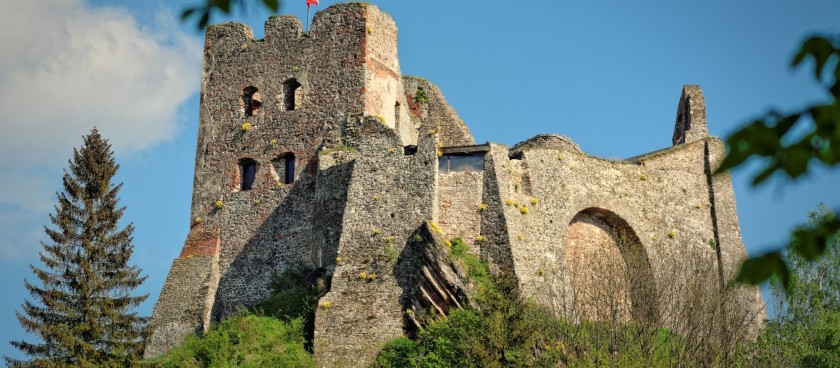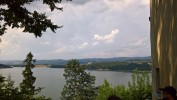- #PL34
- kontakt@zalewczorsztynski.pl
- http://www.zamekwczorsztynie.pl/
- Working hours*:
May - September:
09:00- 18:00
October - April
10:00 - 15:00
Closed: 1 January, 1 November, 25 and 26 December, Easter - Prices*:
Normal - 6PLN
Reduce - 3PLN - * - opening and closing times as well as entrance prices, are subject to alterations without notice. Visitors are advised to check before visiting.
- 49.4357310, 20.3189480 Copy to clipboard Copy
-
#Castles , #Family time
History
Czorsztyński Castle rises in the top part of Castle Mountain (588 m) built of red limestone. It was a Polish stronghold erected on a rock 95 meters above the Dunajec River.
He played an important role of the border fortress on the old route connecting Małopolska with Hungary. Although the main trade route to Hungary ran through Nowy Sącz, this was the diplomatic way, longer but safer.
The beginnings of the castle are not exactly known. Probably at first there was a wooden castle here, to which the "stolp" - cylindrical tower was then added. It was called Wronin, although this name was assigned to another elevation to the north-west of Castle Hill.
Długosz lists the name Jan Wydżga of the Janina coat of arms as the owner of the castle, which from 1249 was the dignity of the old castellan of Opole. He had the same Wydżga to find abundant gold veins on the Hungarian border, and dying to leave clues about mines in the Sącz region. However, history does not put him too favorably for his cooperation with the Teutonic Knights.
However, the first mention refers to the year 1241, when the castle was to take shelter from the Tatar invasion Bolesław Wstydliwy z Kinga.
The brick castle was built in the 14th century during the reign of Casimir the Great, who traveled to Hungary and probably visited the castle in 1335, going to the congress in Visegrad and in 1339 and 1369. In 1370, after the death of Casimir the Great, he traveled to Krakow, Ludwik Węgierski.
As some wish, at the end of the fourteenth or the beginning of the fifteenth century, Czorsztyn passed into the hands of Zawiszy Czarny of the Sulima coat of arms, who also received the Spiš starosty from the Hungarian King Zygmunt I for his services during the wars in Turkey. Around 1400, the castle was to be conquered by the outlaws, Słupecki, the coat of arms of Rawicz and Jan Rogale, the castellan of Włocławek, and was refuted at the order of Jagiełło only in 1402.
King Władysław Jagiełło visited the Czorsztyn castle many times. In 1412, he entertained here and then handed over 37 thousand to Niedzica castle. on the silver grosz of Prague, as a loan for the Hungarian king Zygmunt Luxembourczyk, pledging land in the Spiš region.
Here, too, in 1440 he wiggled with his mother, Władysław Warneńczyk, setting out on an expedition against the Turks.
In 1543, the starost of Czorsztyn was Piotr Kmita from Wiśnicz, the voivode of Kraków, and the great marshal of the Crown. It was him and his officials who complained to the king of the inhabitants of the surrounding villages, complaining about additional, hard work, commissioned to them by the staroste. In the first half of the 17th century, the castle was rebuilt by the starost Baranowski, who did great harm to his subjects. Even the city of Kroscienko complained to the king that Baranowski forbids the townspeople to fish in the Dunajec, to demand money and to free their felling for their own needs in the forests of arms. It is his name that has a tower through which one enters the yard of the middle castle.
In 1651, the poorly guarded castle was conquered by the rebellious peasants under the leadership of Aleksander Kostka Napierski. It was easy for them, because the governor Jerzy Platenberg, an Livonian nobleman, let the castle leap himself, following his people to Ukraine, to join the royal army fighting Khmelnytsky. Only a few Jews who rented the property lived in it.
From the Czorsztyn castle, Napierski sent manifestos promising in the name of the king, freeing them from burdens and mobilizing them to fight.
The Dobczyce elector, Mikołaj Jordan headed the group of 85 soldiers against him. Later, more troops were thrown at the appeal of Bishop Gembicki.
In total, about 1000 people stood against Napierski (some say 2000) people with 6 cannons.
Rebellious peasants, when they saw their hopeless situations, issued their leaders. Napierski and two other leaders, Łętowski and Radocki, were transported to Krakow and sentenced to death. Napierski was killed on a stake and his companions were felled and quartered.
The figure of Napierski quickly became legendary and the authorities of People's Poland tried to create his myth as a defender of the oppressed people. However, it is very likely that he acted on behalf of the Swedes and Khmelnytsky.
The next ruler visiting the castle was Jan Kazimierz, who in 1655 was leaving Poland before the Swedes.
In the 18th century, the castle suffered from wandering various forces during the dynastic battles between August III and Stanisław Leszczyński. In 1735, the Russian army, brought by August's supporter, the starost of the Spiš, Teodor Lubomirski, plundered the castle and the surrounding area, imposing on the starosty contributions in the amount of 50,000 tons.
In 1769 the castle was occupied by the Barycy confederates, but soon they were driven out of the Austrian army.
The last staroste was Józef of Potoka on Monastyrzyska, Potocki, starosta also Halicki, Castellan of Lviv, colonel of the Crown troops, who took Czorsztyn in 1763 and was in his possession until his death in 1797 - though he left it already in 1790. In 1790, the castle roof burned down from the lightning and from that moment he began to fall into ruin. After the death of the wife of the staroste, the staroste
Józefa Potocka, the castle was taken over by the Austrian government. Until the beginning of the 19th century, the castle hill and neighboring rocks were not afforested, which was maintained from the Middle Ages due to the defense of the castle.
In 1819, the Czorsztyńskie property was purchased by Jan Maksymilian Drohojowski and remained in the hands of the family until the nationalization in 1945.
From 1951, conservation works were carried out at the castle.
Currently, the castle, with a partially rebuilt upper and middle castle, can be visited individually by buying tickets at the museum's box office.

